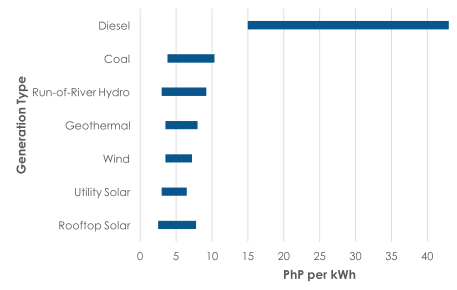The Philippines has expensive retail electricity: partly for historic governance and competition reasons, and partly because it is a archipelago of 7000 islands. Taxes raised on normal consumers are used to subsidise extremely expensive diesel-powered electricity generation 100% on many scattered islands whilst cheap distributed solar electricity can now be produced for only 25% of the price of diesel-powered retail electricity. This price difference is a stark opportunity for Philippines consumers to take advantage of the abundant free sunshine that pours onto each island everyday by just installing rooftop solar panels and DC to AC inverters. Rooftop solar will replace dirty expensive retail electricity with clean electricty generated directly almost for free ! The graph below shows wholesale prices but these will double if you buy your electricity from a normal distribution company because of their profits and many many taxes. LCoE Electricity prices do not include distribution charges or any of the special Philippines surcharges for missionary, exchange rate adjustment and fossil fuel price increase charges. You are not taxed anything or surcharged on electricity that you make yourself and making electricity locally can increase resiliency and efficiency.

Furthermore, now is the best time ever to install solar power now from photovoltaic panels (PV Panels) because their price has been falling for decades and is now the cheapest ever: down over 85% from just 10 years ago and down 99% from last century.

Many organisations that try to help people around the World have noticed the huge opportunity for rooftop solar power in the Philippines and these philanthropic organisations have prepared detailed reports to explain the current problems and glorious opportunities to save money, capture free energy, and then enhance development generally and especially in smaller communities. The Philippines has many electricity blackouts and brownouts so making electricity yourself can assist local batteries and generators when the grid supplies are too weak or have failed. This 2018 report: by Sarah Ahmed and IEEFE explains all the problems and opportunities very well. Some quotes are taken from her report and pasted below:
'Solar energy makes sense for consumers especially in areas such as Visayas and Mindanao which are already experiencing rotating brownouts. It provides an immediate solution that can be installed and commissioned in as short as a few days. According to the EPIA, a 1-MW solar power plant can be installed in under six weeks, while smaller systems only take a day to install.'
'Solar facilities are also easy to put up, scalable, and relatively unobtrusive. Solar panels can also be placed on rooftops and other parts of a building without taking up any space. These solar panels are also relatively maintenance-free.'
'The country can also take advantage of its abundant sunlight. According to the National Renewable Energy Laboratory, the Philippines' average solar radiation ranges from 128-203 watts per square meter, or an average of 161.7 watts per square meter giving a potential power generating capacity of 4.5-5.5 kWh per square meter per day whilst areas in the south can produce an average of 5-5.5 kWh per square meter of solar power per day.'
My business interest is in developing large rooftop solar installations in the Philippines like those that I own in Australia. However, solar PV can work efficiently and cheaply at wholesale, gridscale, home and off-grid at both small or large scales too. The Philippines has many small retailers who can sell and advise you on smaller systems but prices per peak Watt will be at least twice as high as a larger system. If you would like some free advice on how to install solar PV systems and how much money you will save, please email (fs@ filsolar .com) or call Dr Jeremy D. Parsons here in the Philippines: +63 945 1940 708
I can give advice on funding too. Interest rates in Europe are approximately zero in Europe now so funding can be cheap. Solar PV electricity is very bankable because the panels are made from anodised aluminium and strengthened glass and the pre-wired connectors (MC4) are heat, UV and water resistant. Furthermore, the added strength and weight of solar panels installed below the peak roof height will normally strengthen roofs and reduce the lifting force caused by strong winds, especially if lift-spoilers are used on the corner panels.
In summary, installing rooftop solar power can reduce the risk of brownouts, reduce the risk from winds, reduce the electricity cost, provide electricity where there was none available before and also reduce the risk from global climate change - entirely good outcomes for everyone!
| Renewable Energy | Personal Home Page | Green transport | Electric Bicycles | Solar in The Philippines |